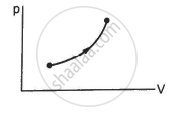Advertisements
Advertisements
प्रश्न
A gas in equilibrium has uniform density and pressure throughout its volume. This is strictly true only if there are no external influences. A gas column under gravity, for example, does not have the uniform density (and pressure). As you might expect, its density decreases with height. The precise dependence is given by the so-called law of atmospheres
n2 = n1 exp [-mg (h2 – h1)/ kBT]
Where n2, n1 refer to number density at heights h2 and h1 respectively. Use this relation to derive the equation for sedimentation equilibrium of a suspension in a liquid column:
n2 = n1 exp [-mg NA(ρ - P′) (h2 –h1)/ (ρRT)]
Where ρ is the density of the suspended particle, and ρ’ that of surrounding medium. [NA is Avogadro’s number, and R the universal gas constant.] [Hint: Use Archimedes principle to find the apparent weight of the suspended particle.]
उत्तर १
According to the law of atmospheres, we have:
n2 = n1 exp [-mg (h2 – h1)/ kBT] … (i)
Where,
n1 is the number density at height h1, and n2 is the number density at height h2
mg is the weight of the particle suspended in the gas column
Density of the medium = ρ'
Density of the suspended particle = ρ
Mass of one suspended particle = m'
Mass of the medium displaced = m
Volume of a suspended particle = V
According to Archimedes’ principle for a particle suspended in a liquid column, the effective weight of the suspended particle is given as:
Weight of the medium displaced – Weight of the suspended particle
= mg – m'g
`= mg - V rho'g = mg - (m/rho)rho'g`
`= mg (1-(rho')/rho)` ...(ii)
Gas constant, R = kBN
`k_B = R/N` ....(iii)
Substituting equation (ii) in place of mg in equation (i) and then using equation (iii), we get:
n2 = n1 exp [-mg (h2 – h1)/ kBT]
`= n_1 exp[(-mg(h_2 - h_1))/ (k_BT)]`
`= n_1 exp [-mg(rho - rho')(h_2 - h_1) N/(RTrho)]`
उत्तर २
Considering the particles and molecules to be spherical, the weight of the particle is
`W = mg = 4/3 pir^3rhog` ... (i)
Where r = radius of the particle and rho = density of the particle. Its motion under gravity causes buoyant force to act upward which is equal to
B= Volume of particle x density of the surrounding medium x g
`= 4/3 pir^3rho'g`
if F be the downward force acting on the particle then
`F = W - B = 4/3 pir^3(rho -rho')g` .....(iii)
Also `n_2 = n_1 exp[(-mg)/k_BT(h_2-h_1)]` .... (iv)
Where `k_B` - boltzman constant
`n_1` and `n_2` are number densities at height `h_1` and `h_2` respectvely. Here mg can be replaced by effective force F given by the equation (iii)
:. From iii and iv we get
`n_2 = n_1 exp [-(4pi)/3 r^3 ((rho -rho'))/(k_BT) g(h_2 - h_1)]`
`= n_1 exp [-(4pi)/3 r^3 (rhog(1-(rho')/rho)(h_2-h_1))/((RT)/N_A)]` [∵ `K_B = R/N_A`]
`n_2= n_1 exp [- (mg N_A(1-(rho')/rho)(h_2-h_1))/(RT)]`
which is required relation where `4/3 pir^3 rhog` = mass of the particle x g = mg
APPEARS IN
संबंधित प्रश्न
An air bubble of volume 1.0 cm3 rises from the bottom of a lake 40 m deep at a temperature of 12 °C. To what volume does it grow when it reaches the surface, which is at a temperature of 35 °C?
Calculate the mass of 1 cm3 of oxygen kept at STP.
Estimate the number of collisions per second suffered by a molecule in a sample of hydrogen at STP. The mean free path (average distance covered by a molecule between successive collisions) = 1.38 × 10−5 cm.
Use R = 8.31 JK−1 mol−1
A vertical cylinder of height 100 cm contains air at a constant temperature. The top is closed by a frictionless light piston. The atmospheric pressure is equal to 75 cm of mercury. Mercury is slowly poured over the piston. Find the maximum height of the mercury column that can be put on the piston.
A uniform tube closed at one end, contains a pellet of mercury 10 cm long. When the tube is kept vertically with the closed-end upward, the length of the air column trapped is 20 cm. Find the length of the air column trapped when the tube is inverted so that the closed-end goes down. Atmospheric pressure = 75 cm of mercury.
Work done by a sample of an ideal gas in a process A is double the work done in another process B. The temperature rises through the same amount in the two processes. If CAand CB be the molar heat capacities for the two processes,
The value of Cp − Cv is 1.00 R for a gas sample in state A and 1.08 R in state B. Let pAand pB denote the pressures and TA and TB denote the temperatures of the states A and B, respectively. It is most likely that
The figure shows a process on a gas in which pressure and volume both change. The molar heat capacity for this process is C.

The molar heat capacity for the process shown in the figure is

A sample of an ideal gas (γ = 1.5) is compressed adiabatically from a volume of 150 cm3 to 50 cm3. The initial pressure and the initial temperature are 150 kPa and 300 K. Find (a) the number of moles of the gas in the sample (b) the molar heat capacity at constant volume (c) the final pressure and temperature (d) the work done by the gas in the process and (e) the change in internal energy of the gas.
